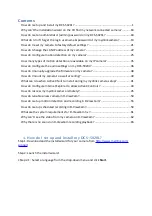
#33
Main
POWER
switch
#34 FUSE
(see page 13)
#35 POWER
connection
#36 DVI
output
(see below and page 13)
#37 USB
port
(see page 8)
#38 RS-232
port for external remote
controlling
(see page 13)
CONNECTORS
#39 PREVIEW
RGB
output for control monitor
#40 RGB
output 15-pin
(see below)
#41 EXTERNAL Input
for Computers (
see page 8)
#42 RGB
output BNC connectors
(see below)
#43 PAL/NTSC S-Video
(Y/C) output
(see page 12)
#44
PAL/NTSC Composite video
output
(see page 12)
#45
LAN
10/100 TBASE
(see page 8)
33
35
34
The RGB-, Preview- and DVI-outputs can output a signal in the following formats:
- VGA / 60 (4:3 - 640x480 Pixel) at 60Hz
- SVGA (4:3 - 800x600 Pixel) at 60Hz, 75Hz or 85Hz
- XGA (4:3 - 1024x768 Pixel) at 60Hz, 75Hz or 85Hz - native image
- SXGA- (4:3 - 1280x960) at 60Hz or 85Hz
- SXGA (4:3 - 1280x1024 Pixel) at 60Hz, 75Hz or 85Hz
- SXGA+ (4:3 - 1360x1024) at 60Hz or 75Hz
- UXGA (4:3 - 1600x1200 Pixel) at 60Hz
- XGA 16:9 at 60Hz (special format for not HDTV-capable 16:9-Plasma displays)
- WXGA/60 (16:9 Widescreen - 1366x768 Pixel at 60Hz)
- WSXGA+/60 (16:10 Widescreen - 1680x1050 Pixel at 60Hz)
- 720p/50 (16:9 Widescreen HD/HDTV - 1280x720 Pixel at 50Hz)
- 720p/60 (16:9 Widescreen HD/HDTV - 1280x720 Pixel at 60Hz)
- 1080p/50 (16:9 Widescreen HD/HDTV - 1920x1080 Pixel at 50Hz)
- 1080p/60 (16:9 Widescreen HD/HDTV - 1920x1080 Pixel at 60Hz)
The "
Auto Resolution
" function is activated by default. In this mode the Visualizer constantly checks
which devices are connected to RGB
(#39, 40)
and DVI output
(#36)
and automatically sets the optimal
output mode for each connected device separately.
Please note that the Visualizer can not check the possible resolution, if the connected units or the
cables* are not "Plug and Play" compatible. If the Visualizer can not detect the resolution of the
connected device, the output is set to the default of XGA (1024x768)/60Hz.
(* Cables with plug and play compatibility must have a 15-pin plug on both ends with all pins connected, pin 9 is not used)
If you can not use the “Auto Resolution” function, you can select the output mode manually in the on-
screen menu of the Visualizer. Resolution and refresh rate can be adjusted separately for the outputs.
In order to achieve the best picture quality you must set the outputs of the Visualizer to match the native
resolution of your display unit (e.g. LCD or DLP projector or monitor).
Important: What matters is the native resolution of the projector or monitor, not the maximum resolution
that it can display (in compressed mode). The native resolution is the actual number of pixels of the built
in LCD display or DLP chip of a projector or monitor. Most LCD or DLP projectors can also display higher
resolutions than their native resolution, but only in compressed mode and with inferior picture quality.
Do
NOT set the output of the Visualizer to a higher standard than the native resolution of your
display unit!
If you output the Visualizer image on a CRT-monitor or CRT-projector, use an output mode with 75Hz or
85Hz, because 60Hz may show a slight image flickering. For LCD/DLP-projectors or -monitors and video
conferencing units 60Hz is the best choice. If you are unsure what is the best mode, check the user
manual of the connected units.
Do not set a higher refresh rate than your monitor or projector can display, otherwise the monitor
or projector can be damaged! Follow the instructions in the user manual of the connected units!
Choosing the right output mode
11
FUSE
T3,15A
RGB
40
PREVIEW
EXTERN IN
39
41
R
G
B
42
DVI
USB
38
S-VIDEO
Video
36
37
43
44
LAN
45
RS-232
V
H
Summary of Contents for VZ-27plus
Page 18: ......











































